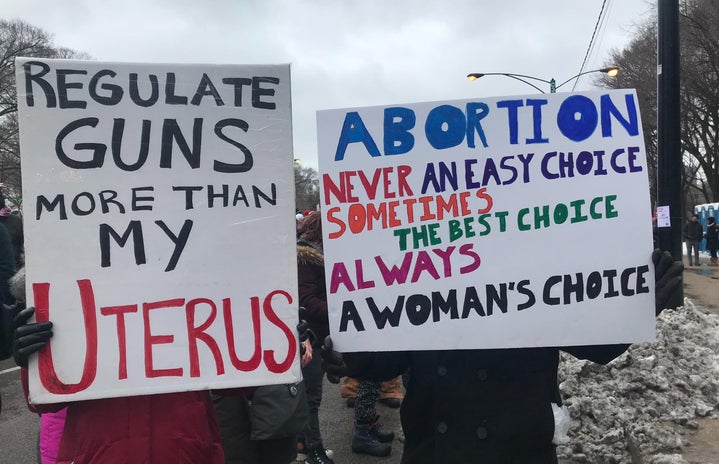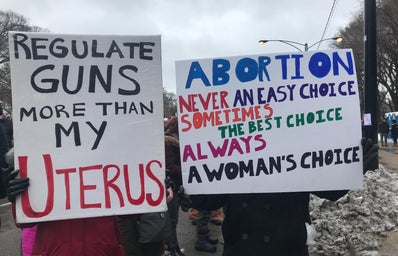The federal government, with approval from the Food and Drug Administration (F.D.A.), authorized abortion pills to be available for delivery by mail earlier this month, a bold and relieving move towards the U.S.’s uphill climb against the strict abortion laws being passed in various states throughout the country.
With actions such as the Dobbs v. Jackson Women’s Health Organization case and the Texas abortion ban (nicknamed the “Texas Heartbeat Act”) threatening Americans’ right to legal abortions, this authorization is a glimmer of hope for Americans with a uterus right now, who are still suffering from the Covid-19 pandemic and a heavily Republican appointed Supreme Court likely to favor against the rights provided to them through Roe v. Wade.
The abortion pill, mifepristone, is the first of two pills taken to terminate a pregnancy, the second being misopristol which helps with the side effects such as cramping and bleeding. It is a common method used for pregnancies up to 11 weeks gestation.
Lourdes Rivera, Senior Vice President of U.S. Programs at the Center for Reproductive Rights, said that the Center “applauds” the F.D.A. for this authorization.
“This decision will expand access to medication abortion care for many, including for Black, Indigenous and People of Color, those working to make ends meet, members of the LGBTQI+ community, immigrants, people with disabilities, young people, and those living in rural communities,” said Rivera.
The concerns over abortion access are especially present during the pandemic.
“If you’re living with someone where they’re the money-earner and the driver, and their beliefs can dictate your actions, and they don’t want you to get an abortion, and you’re both home because of the pandemic, and it’s a situation where you can’t hide a pregnancy before deciding to terminate it on your own, that’s the biggest concern,” said Clare Martin (they/she), a sophomore at New York University, recalling the initial reaction to the pandemic in relation to abortion access. The remote access to the pill aids these concerns.
Lourdes Rivera, however, stresses that there is still much to be done in ensuring that Roe v. Wade stays in place.
“Anti-abortion politicians in 19 states—including Texas and Mississippi—have already passed laws that limit the impact of today’s significant announcement, and 24 states are poised to act immediately to ban abortion if the Supreme Court overturns Roe v. Wade,” said Rivera. “To truly expand access to abortion care, all of the FDA’s restrictions on mifepristone, and other obstacles to abortion access – including unconstitutional bans and prohibitions on telemedicine — need to be removed.”
Dobbs v. Jackson Women’s Health Organization hit the Supreme Court on December 1, 2021. The case was filed in 2018 by The Center for Reproductive Rights on behalf of Jackson Women’s Health Organization. The Organization is the last abortion clinic in Mississippi, challenging the red state’s ban on any abortion after 15 weeks of pregnancy. The case revolves around the constitutionality of fetal viability, which currently stands at around 23-24 weeks.
Nancy Northrup, president and CEO of the Center for Reproductive Rights, said that these powerful laws are being put in place by right-wing states’ governments during this time in an effort to dismantle Roe v. Wade while Americans are in a vulnerable state.
“These same states have tried to ban abortion access for years; no one should be fooled that this is warranted by the current crisis,” said Northrup. “We will use every legal means to ensure that abortion care remains available during this critical time.”
At least nine states have taken action during the pandemic to heavily restrict abortion laws, according to Autumn Katz and Nimra Chowdhry, representatives for the Center for Reproductive Rights. These states started by, “postponing all non-urgent, non-essential, and/or elective medical procedures and surgeries to combat the Covid-19 pandemic,” which included abortions.
Katz and Chowdhry, however, explain that abortions don’t require much of the supplies and/or PPE that would be needed for abortion services, especially since most can be done orally with the abortion pill.
Kristine Kemmer (she/her), a sophomore at California State University, Fresno, said she finds it “hypocritical” for these states to be implementing strict abortion laws when these state officials are the same ones fighting for their right to not wear a mask because it’s their “right.”
“In places like Texas where women’s rights are being attacked, anti-vaxxers claim they have the right to put others at risk by not getting vaccinated because they have a right to their own body,” said Kemmer. “The flawed logic aside, those same people that claim they have bodily autonomy are denying those rights to individuals with uteruses.”
The Supreme Court currently holds a 6-3 ratio in those appointed by a Republican president versus those appointed by a Democratic president. While the judges don’t technically side with political parties, the 6-3 ratio is said to hold true to Republican-leaning versus Democrat-leaning judges.
However, Chief Justice John Roberts has surprised many with his rulings in recent cases, such as S.B. 8, the Texas Heartbeat Act, which banned abortions after 6 weeks – aka the first time a heartbeat can be detected in a pregnancy. The ruling on S.B. 8 went 5-4, with Roberts voting to block the Texas ban with fellow Justices Sonia Sotomayor, Stephen Breyer, and Elena Kagan.
Roberts said that S.B. 8, “has had the effect of denying the exercise of what we have held is a right protected under the Federal Constitution.”
The Chief Justice is likely to vote against striking down Mississippi’s abortion law in Dobbs v. Jackson Women’s Health Organization, however, since he and the five other more-Conservative justices gave signals that they were comfortable with the law.
In the Texas Heartbeat Act hearings, Roberts also said that “The nature of the federal right infringed does not matter; it is the role of the Supreme Court in our constitutional system that is at stake,” a statement that many Americans with a uterus are also thinking.
The true intentions of these decision-makers, both at the Supreme Court and state levels, are being called into question by the Americans these abortion laws directly affect.
“[These laws] are disguised as laws that promote and increase life, however their true intention is to decrease the control women have over their bodies,” said Delany Davis (she/her), a 19-year-old from Clovis, California. “If governments truly cared about protecting a child’s life, they would invest more money and attention to the foster care system and to women who are underprivileged financially. They would increase the amount of sex education for young women and put more of an effort into educating and holding men accountable for their actions [in situations of rape and domestic violence].”
Many women, like Brenna Dougherty (she/her), a sophomore at California State University, Fresno, didn’t get a lot of education on reproductive health or options growing up, and the state of women’s rights over their bodies was a big shock.
“The constant threat that I don’t have full control or say over my body is ridiculous and not something I thought that I would have to deal with,” said Dougherty.
Brittany Andrews (she/her), a mother of two living in Fresno, talked about how the states that are putting these abortion restrictions into place are the same states that are heavily un-vaccinated against Covid-19 and are against gun control.
“Maybe they don’t do it consciously, but I feel like this is just another way to keep people oppressed, or keep them in a povern state,” said Andrews. “I mean, you’re creating a problem where there doesn’t need to be one.”
Another mother in Fresno, California who wishes to remain anonymous said that having had an abortion herself, she couldn’t imagine what it would have been like if she wasn’t able to access it the way she was able to. She was only 19-years-old and living in a dangerous and unstable environment at the time, so in her situation, it was the way she needed to do it.
“My mom is really against abortion, so I couldn’t use my insurance for anything,” she said. “The fact that there was a place like [Planned Parenthood] where I could go and get it done without anyone knowing was so important.”
The remote access to the abortion pill is a step in the right direction, but the concerns over the laws granting Americans the right to a safe, legal abortion – i.e. the survival of Roe v. Wade – don’t just go away.
“The thing that really scares me about [these laws] is these people who are comfortable and safe in their households saying ‘abortion is healthcare’ without having to worry about like someone they depend upon for food and shelter, based on the stickiness of their life’s situation, like turning on them or just disagreeing with them in a really unsafe way,” said Clare Martin. “It doesn’t feel like there is enough urgency behind those people’s actions and words about what’s happening to the people who are just as deserving and in need of an abortion who happen to live in a more rural, republican community.”


